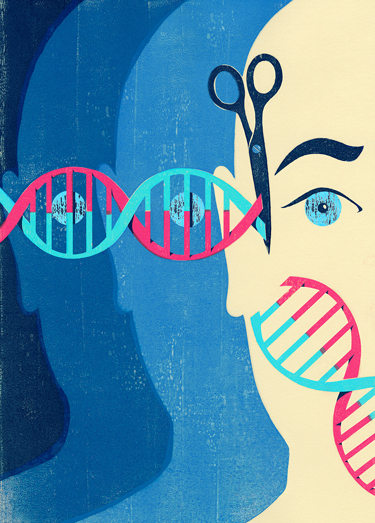Discoveries
DNA Cut and Paste
Aug 09, 2017 Cedars-Sinai Staff

Illustration: Dan Bejar
Movies, books, and articles all benefit from good editing. So does science: Gene editing may be the answer to treating or hindering many inherited diseases, such as retinitis pigmentosa, a form of blindness.
In a study using animal models, Shaomei Wang, MD, PhD, and her team used a revolutionary technique known as CRISPR/Cas9 to remove the genetic mutation that causes the degenerative eye disease. Retinitis pigmentosa currently has no known cure and affects some 100,000 people in the United States alone.
"The study was a breakthrough," says Wang, a research scientist in the Board of Governors Regenerative Medicine Institute’s Eye Program, associate professor of Biomedical Sciences, and the lead author of the study. "It suggests that some forms of retinitis pigmentosa may soon be treatable."
In less than five years, CRISPR/Cas9 has transformed the science of genome editing by making it easy, cheap, and fast to move genes around in any living organism, from bacteria to people. This is nothing short of a revolution in biomedical research. (CRISPR stands for clustered regularly interspaced short palindromic repeat, the type of DNA sequences involved in this process.)
The technique is adapted from a system that bacteria use to defeat invading viruses. The bacteria first copy part of the invader’s genetic code into a special sequence of ribonucleic acid (RNA), which acts as a messenger to carry out the code’s instructions. When the virus returns, the RNA binds to a protein called Cas9, guides it to the matching gene in the virus, and thereby disables the gene.
By modifying this system, scientists can program the Cas9 protein to turn selected genes on or off, or rewrite a genetic code, giving them the potential to correct the mutations that make cancer cells multiply, defend cells against the AIDS virus, or — in the case of the Cedars-Sinai group — delete the culprit behind retinitis pigmentosa.
“We couldn’t be more excited,” Wang says. “Things are moving faster than we ever imagined for patients suffering from this disease.”


